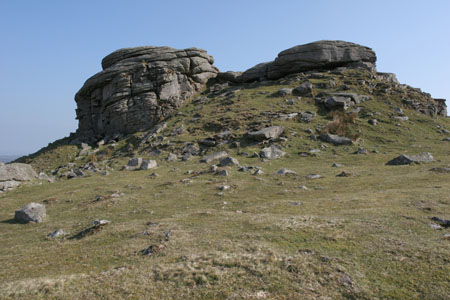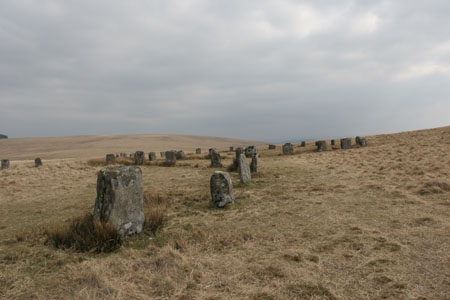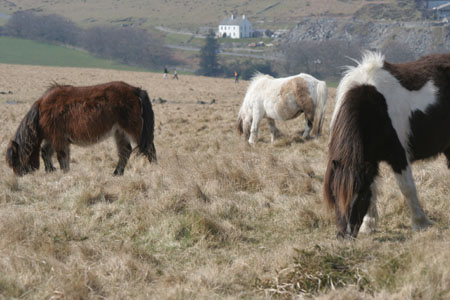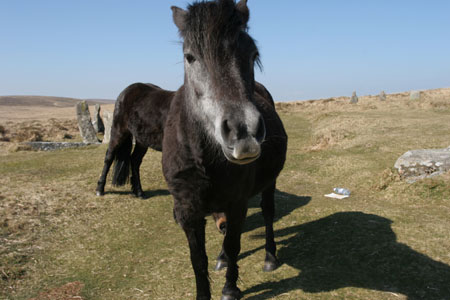Apart from that, Sir Henry, how was the Dinner?
Dartmoor
Main -- House -- History -- Cornwall -- Getting There -- On the Road -- The Roads -- London -- The Far West -- Boring Details -- Updates
Along the way to Cornwall you're likely to drive on the A30 just along the north edge of Dartmoor, one of England's great national parks. Dartmoor is most famous, in popular culture, as the principal setting of Arthur Conan Doyle's great Sherlock Holmes novel, The Hound of the Baskervilles. This screenshot from the opening sequence of the famous Basil Rathbone/Nigel Bruce movie of the novel tells you what you need to know:
 |
Well, okay. That doesn't sound so great. But then, if you're pretty sure the landscape is haunted by a supernatural hell-hound intent on ripping your throat out, it's liable to have an adverse effect upon your opinions of the local scenery. Now, if Henry Baskerville had been pursued by a great supernatural goose laying golden eggs, he'd probably have been a cheerier man and the film wouldn't have been quite so moody. |
The moor is today regarded as a place of exceptional natural beauty, and Holmes shot the hound in the final scenes of the book so the supernatural hell-hound problem is now relatively under control. The moor is basically a big chunk of granite, covered in most places by acidic peaty soil and low brush, but featuring great bare granite peaks -- "tors" -- which overlook the flatter and lower parts of the moor. In the lower areas there are grasslands and great fields of heather and wetland plants--and in place of the Grimpen Mire of the famous novel there is Foxtor Mire, a great peat bog. The moor was once more fertile, and so is dotted all over with the remains of settlements of every era. At Great Hound Tor (named for a legend which inspired the Hound of the Baskervilles) is an abandoned medieval farming village; at Grimspound is a bronze-age encampment, the most impressive of a large number of such camps and hut circles found all around the moor; mining sites only a century or two old, the UK's newest castle (Castle Drogo), ancient stone rows and stone circles of the bronze and stone ages, "clapper" bridges of unknown but presumed great age, crosses set to mark footpaths across the moor, and other odd and mysterious structures dot the landscape. |  Kes Tor, one of the many beautiful granite peaks I have forced my daughter to climb. Without video games. |
 Grey Wethers Stone Circle |
 Ponies. All over the danged place. |
There is, of course, a great deal to know about Dartmoor and all of its various attractions. To see more, visit the official website for Dartmoor, full of snazzy info.
Dartmoor is one of the UK's great remaining "common" lands; while the word "commoner" has acquired a more general modern meaning, it once referred to a person who had a right to common grazing and resource lands; great stretches of the moor are unsuitable for farming but well-suited for low-intensity grazing, so are populated by sheep, ponies, and cattle which wander freely over almost the whole landscape. The moor itself is mostly open to public access--and there are countless long walks to be had out into the semi-wild moor, to see viewpoints, monuments, streams, and tors. It's a good idea to bring some decent shoes for a hike--as it is easy, in some places, to find yourself either suddenly stepping into a foot of mud (not as likely in June/July as the rest of the year) or turning your ankle on a tuft of grass standing on a dried-up mound of previously-wet soil. Something that at least covers your ankles is recommended, and a change of socks is a good thing to have in your pack. And don't be surprised if you get mugged by a pony.
Mynd you, Møøse bites Kan be pretti nasti:Well, those ponies are a handful. One minute, you're photographing the Scorhill stone circle, enjoying the quiet of the open moor and the soft breeze, and the next, you're being mugged by ponies for the goodies in your backpack. Here, one is about to demand all the food in my pack, and they do get nudgy...cute buggers, though. |  |